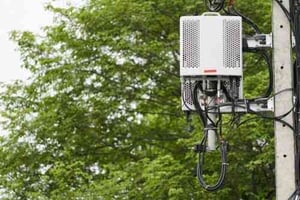5 Ways Small Cell Wireless is Changing Connectivity

For wireless consumers, small cell wireless promises ultra-fast connections, stronger signals, and exciting new technology and services. For joint use professionals, managing the deployment of small cell equipment presents new challenges, as well as opportunities.
What Is Small Cell?
If you read the other articles in this series, or if you are a joint use professional, you are familiar with the latest small cell technology.
To recap, small cell is a compact antenna system ranging from the size of a TV remote to as large as a small refrigerator, and it provides wireless service to limited coverage areas. It serves anywhere from a handful of users to several hundred, depending on the type of small cell attached.
Small cell equipment is often attached to utility poles and streetlight poles or mounted on buildings or amphitheaters.
5 Key Ways Small Cell Is Changing Connectivity
While there are many expected improvements as a result of small cell technology, below is a list of five specific advancements.
1. 5G Evolution
The new generation of wireless networks will support heavy use of video and meet consumer demands for faster, more dependable connections. Downloading a feature-length movie (which takes about 6 minutes with 4G) will take an estimated 3.6 seconds with 5G.
The rollout began in 2019 for the next generation of mobile tech. Although the pandemic slowed the momentum in 2020, Pocket-lint reports that 250 million Americans have coverage for low-band 5G available, and both AT&T and Verizon offer top-level, high-band 5G in about 30 U.S. markets so far. Several phone manufacturers including Samsung and Nokia offer 5G models, with Apple announcing its first 5G iPhones in October 2020.
2. Staying Connected
Consistent coverage has become a necessity. Small cell wireless has the capacity to mend existing gaps in coverage through geo-targeted placement of small, limited-range attachments. A report found that 96% of people born in 1980 or later stated that mobile phones were the single most important item used in their daily life. Developments, ranging from coffee shops to apartments and office buildings, now commonly include cellular infrastructure as an amenity in their building space.
3. Expansion of IoT (Internet of Things)
The IoT rule is that “Anything that can be connected, will be connected.” Integrated technology is here, and users are multiplying rapidly, although at a somewhat slower pace than the most optimistic forecasters predicted. According to AxisBits, the global IoT market is expected to double from 2019 to 2021 and triple from 2019 to 2025, reaching $1.6 trillion. The number of IoT devices in use is expected to grow from 26.7 billion in 2019 to almost 75.5 billion in 2025.
Coordinated connections among vehicles, appliances, and home systems create high density demands on wireless connectivity. Small cell wireless will add reliability to users’ control of such systems. IoT also encompasses wearable tech, health-monitoring devices and many other possibilities.
4. Filling in Coverage Gaps
Some places, such as a concrete stadium filled with 80,000 sports fans and their devices, are especially challenging for wireless service. Small cell wireless can improve service in those places, as well as airports, transportation hubs, hospitals, government buildings, and densely developed urban areas.
5. Safety Enhancements
Because of expanding coverage and consistent connectivity, safe access to service across the country will potentially increase. When emergencies occur, victims or bystanders can rest assured that their cell phone service will reach the other end of the call. First responders rely on networks and cell service to communicate life-saving instructions to their field crews. Currently, cities that plan to convert to smart cities are focusing on public safety as priority, as well as energy and transportation.
These five predicted outcomes of small cell technology will expand the nation’s ability to communicate and stay informed and connected. These five key results are just a few of the reasons to get small cell wireless in place. Small cell has the potential to make wireless customers happier, safer, and more productive with their service.
Challenges of Small Cell Wireless
Even with all the good that small cell technology brings, there are challenges that follow. Behind the scenes, paperwork and requests are flooding asset owners’ desks. No official process has been documented for joint use departments to deal with the incoming volume of small cell inquiries.
Municipalities are scrambling to create official regulations. The differences in past regulations contributes to the confusion of the small cell boom. Some states allow more attachment options than others, and requirements may vary for height, circumference, and the type of antenna allowed.
In the meantime, asset owners bear a considerable burden. The safety and reliability of a company’s power system is of utmost importance, so careful attention to joint use departments is a must.
Some asset owners have reported receiving joint use requests for small cell attachments in a variety of ways. Companies that perform utility pole audits are reporting they have more small cell attachments than the number of joint use requests previously received.
Performing the necessary due diligence is a serious challenge. Companies need strong coordination among departments and solid procedures for handling joint use requests and communicating with small cell contractors.
What challenges has the rapid growth of small cell wireless created for you?
How have you addressed these challenges? Let us know how small cell has impacted your business. Help us create a conversation about small cell and joint use management.
Download our guide today to learn how to meet the challenges associated with small cell technology. For questions about our products or services, book a meeting here.